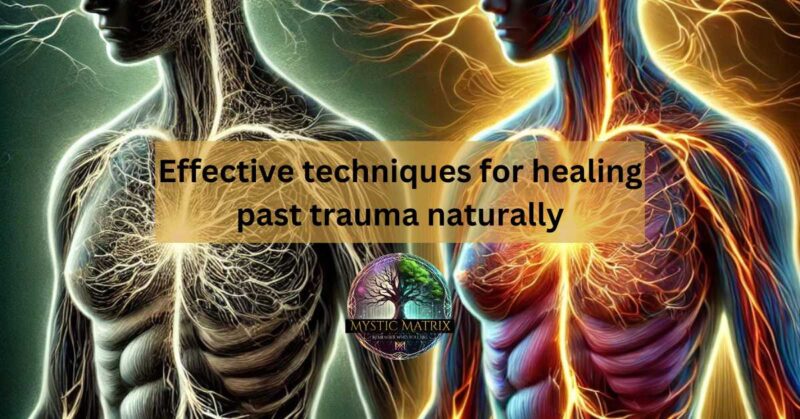Awakening to the Echoes Within
To Healing past trauma is more than revisiting old wounds—it’s about understanding how trauma and conditioning shape your present reality. Many people struggle with deep emotional pain, unaware that their responses, habits, and self-perceptions are rooted in early conditioning. These unconscious patterns often dictate how we engage with the world, influencing relationships, career choices, and emotional well-being.
Unlike conventional approaches that focus solely on therapy or mindset shifts, The Healing Matrix: The 44 Pillars of Transformation takes a holistic approach, integrating nervous system regulation, trauma-informed techniques, and actionable transformation steps. This guide explores ten powerful techniques from The Healing Matrix that will help you in healing past trauma, break free from conditioning, and reclaim your life.
Understanding Trauma and Conditioning
How Trauma Becomes Stored in the Body and Mind

Trauma is not just an event—it’s the imprint that experience leaves on your nervous system. The human brain is wired for survival, meaning that distressing experiences are encoded as a protective mechanism to prevent future harm.
The amygdala, the brain’s fear center, remains in a heightened state, signaling perceived danger even in safe situations. Meanwhile, the prefrontal cortex, responsible for rational thinking, struggles to override emotional reactivity, making it difficult to move forward. The nervous system continuously loops through survival responses—fight, flight, freeze, or fawn—keeping trauma stored in the body long after the initial experience.
The Role of Early Conditioning in Trauma Response
Beyond just the experience itself, how you were conditioned as a child dictates your trauma response patterns. Conditioning refers to the beliefs, behaviors, and emotional patterns you absorbed from caregivers, society, and experiences. If your upbringing reinforced fear, suppression of emotions, or self-doubt, your responses to trauma may be deeply ingrained.
For example, if you were taught that expressing emotions is weak, you may unconsciously suppress pain instead of processing it. If your caregivers were unpredictable, your nervous system may default to hypervigilance and anxiety, expecting instability even in calm environments. If you were conditioned to seek approval for safety, you may develop people-pleasing tendencies, prioritizing the needs of others over your own.
In understanding healing past trauma, this conditioning becomes your default operating system, keeping you stuck in repeating cycles until you consciously reprogram your nervous system and belief system. Healing requires recognizing these patterns and intentionally shifting them.
Breaking Free: Techniques for Healing Past Trauma
Healing past trauma is a process of reintegration, not simply forgetting the past. The following techniques, derived from The Healing Matrix, offer a comprehensive approach that integrates mind, body, and spirit.
Somatic Experiencing: Releasing Trauma from the Body
Trauma is not just a memory—it’s an ongoing physical experience. Somatic experiencing helps the body release stored trauma by engaging the nervous system in a controlled way. Instead of reliving the trauma, somatic techniques allow individuals to process emotions through bodily sensations and movement.
One effective method is body scanning: find a quiet space and slowly bring your awareness to different parts of your body. Notice any areas of tightness or discomfort, and focus on breathing into these spaces, allowing them to soften. With time, this process teaches your body that it is safe, reducing the nervous system’s habitual fight-or-flight response.
Inner Child Reparenting: Healing Emotional Wounds
Many trauma responses originate from unmet childhood needs. The inner child holds the emotional imprints of early experiences, often manifesting as self-doubt, shame, or unworthiness in adulthood.
Reparenting involves actively nurturing the inner child. One way to do this is through self-dialogue—imagine speaking to your younger self with kindness, validating their pain, and offering reassurance. Another method is letter writing, where you write a compassionate letter to your younger self, acknowledging their fears and reminding them they are loved and safe.
Cognitive Restructuring: Changing Limiting Beliefs
Trauma shapes the way we perceive ourselves and the world, often instilling deep-seated negative beliefs. Cognitive restructuring involves identifying and challenging these beliefs, then replacing them with empowering alternatives.
Start by writing down a belief that holds you back (e.g., “I am not good enough”). Then, analyze where it originated—was this belief imposed by someone else? Look for evidence that contradicts it, and create a new, positive belief in its place (e.g., “I am worthy of love and success”). Over time, these new beliefs rewire the brain, helping you shift from survival to self-empowerment.
Nervous System Regulation: Restoring Balance
Because trauma keeps the body in high-alert mode, calming the nervous system is essential. Breathwork is one of the most effective ways to achieve this. The 4-7-8 breathing technique (inhale for 4 seconds, hold for 7, exhale for 8) activates the vagus nerve, signaling safety to the body.
Cold exposure, such as splashing cold water on the face or taking a brief cold shower, also helps reset the nervous system. This small shock interrupts anxiety loops, bringing the body back into balance.
Trauma-Informed Mindfulness: Grounding in the Present

Traditional mindfulness can sometimes feel overwhelming for trauma survivors, as sitting still may bring up unprocessed memories. Trauma-informed mindfulness offers a gentler approach, using grounding techniques to bring awareness to the present without overwhelm.
Instead of focusing on breath alone, engage multiple senses: notice five things you can see, four things you can touch, three things you can hear, two things you can smell, and one thing you can taste. This method anchors you in the present and interrupts trauma loops.
Emotional Expression & Release: Letting Go of Suppressed Feelings
Unprocessed emotions manifest as physical tension, anxiety, and even illness. Movement-based practices, such as dance or shaking exercises, help release stagnant emotional energy.
Something else to consider when Healing Past Trauma, is expressive writing—set a timer for 10 minutes and write without censoring yourself, allowing emotions to flow freely onto the page. Burn or discard the paper afterward to symbolize emotional release.
Nature-Based Healing: Reconnecting with the Earth
Nature has a profound regulating effect on the nervous system. Simply spending time outdoors, walking barefoot on the earth, or sitting under a tree can bring a sense of calm and clarity.
When feeling overwhelmed, try taking a grounding walk in nature, paying attention to the sights, sounds, and sensations around you. This practice restores balance and helps integrate emotional healing.
Integration & Meaning-Making: Transforming Trauma into Growth
True healing comes when you make meaning out of your experiences. Instead of seeing trauma as something that broke you, it can become a source of wisdom and strength.
Journaling can be a powerful tool—ask yourself:
What has my trauma taught me about resilience?
How can I use my healing to support others?
Shifting from victimhood to personal empowerment allows trauma to lose its grip, opening the door for transformation in Healing Past Trauma.
Reclaiming Your Power Through The Healing Matrix
Healing past trauma is a journey of self-discovery, not just recovery. By integrating these techniques and aligning with The Healing Matrix, you shift from survival mode to self-empowerment.
Your Next Steps
✅ Explore The Healing Matrix: The 44 Pillars of Transformation
✅ Commit to one technique from this guide today
Your healing journey starts now. Take the first step. 💛
Thank you for reading our Healing Past Trauma Article, make sure to share with anyone that needs it.


